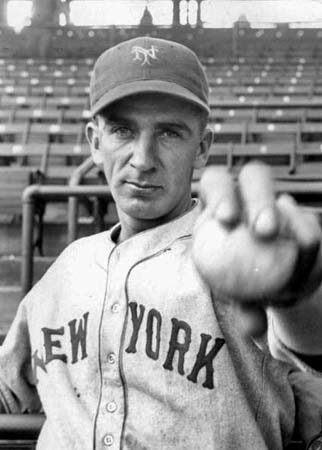Carl Hubbell (Carl Owen Hubbell)

Carl Hubbell was born in Carthage, Missouri and raised in Meeker, Oklahoma. He was originally signed by the Detroit Tigers and was invited to spring training in 1926. However, pitching coach George McBride and player-manager Ty Cobb weren’t impressed with him. Additionally, they were concerned about his reliance on a screwball, a pitch that some believe places an unusual amount of stress on a pitcher’s arm. Hubbell was sent to the Toronto Maple Leafs in the International League before the start of the season. He went 7–7 on a championship team. In 1927 he was invited to spring training again with Detroit, but the Tigers still weren’t impressed and sent him two steps down the minor-league ladder, to the Decatur Commodores of the Illinois–Indiana–Iowa League. Despite a 14–7 record, the Tigers didn’t invite him back for 1928, and he was sent to the Beaumont Exporters of the Texas League., Carl Hubbell was so fed up by this time that he told Beaumont manager Claude Robinson that he would retire and go into the oil business unless he was sold to another organization by the end of the season. Years later, he said that being unloaded by the Tigers was the best thing that ever happened to him. His break came that June, when Giants scout Dick Kinsella decided to take in a game between Hubbell’s Exporters and the Houston Buffs while in Houston for the Democratic National Convention. He hadn’t planned on doing any scouting, but he was impressed by Hubbell. Kinsella called Giants manager John McGraw and mentioned that he knew of Hubbell’s release by Detroit, prompted in part by Cobb’s concerns about the screwball. McGraw replied that Christy Mathewson had a screwball (a fadeaway, as it was called in his time) and it didn’t seem to affect his arm. Kinsella followed Hubbell for a month and was still impressed.
Carl Hubbell would go 10–6 in his first major league season and would pitch his entire career for the Giants. With a slow delivery of his screwball, Hubbell recorded five consecutive 20-win seasons for the Giants (1933–37) and helped his team to three NL pennants and the 1933 World Series title. In the 1933 Series, he won two complete game victories, including an 11-inning 2–1 triumph in Game Four (the run was unearned). In six career Series starts, he was 4–2 with 32 strikeouts and a low 1.79 earned run average. Hubbell finished his career with a 253–154 record, 1678 strikeouts, 724 walks, 36 shutouts and a 2.97 ERA, in 3590 innings pitched. He won 24 consecutive games between 1936 (16) & 1937 (8),[4] the longest such streak ever recorded in major league history. He was twice named National League MVP (1933, 1936) (1st unanimous MVP pick in 1936). He led the league in wins 3 times in 1933 (23), 1936 (26), and 1937 (22). He led the league in ERA three times in 1933 (1.66), 1934 (2.30), and 1936 (2.31). He led the league in innings pitched in 1933 (308). He led the league in strikeouts in 1937 (159). He led the league in strikeouts per 9 innings pitched in 1938 (5.23). He led the league in shutouts in 1933 (10). He led the league in saves in 1934 (eight, retroactively credited). He compiled a streak of 46 1⁄3 scoreless innings and four shutouts in 1933. He pitched a no-hitter against the Pittsburgh Pirates (11–0, May 8, 1929). He pitched an 18-inning shutout against the St. Louis Cardinals (1–0, July 2, 1933). Joe DiMaggio called Hubbell the toughest pitcher he’d ever faced.
In its 1936 World Series cover story about Lou Gehrig and Carl Hubbell, Time magazine depicted the Fall Classic that year between crosstown rivals Giants and Yankees as “a personal struggle between Hubbell and Gehrig”, calling Hubbell “…currently baseball’s No. 1 Pitcher and among the half dozen ablest in the game’s annals.” Time said that while he was growing up on his family’s Missouri farm, he “practiced for hours…throwing stones at a barn door until he could unfailingly hit knotholes no bigger than a dime”. Hubbell was released at the end of the 1943 season. He had posted a 4-4 record that year, marking the only time he didn’t record double-digit wins. However, Giants owner Horace Stoneham immediately appointed him as director of player development, a post he held for 35 years. During that time, he lived in Haworth, New Jersey; he continued to live there after the Giants left New York. The last ten years of his life were spent as a Giants scout. Carl Hubbell died due to injuries suffered in an auto accident in Scottsdale, Arizona in 1988, thirty years to the day after teammate and Hall of Famer Mel Ott died of the same cause. He is interred at Meeker-Newhope Cemetery in Meeker, Oklahoma.
Born
- June, 22, 1903
- USA
- Carthage, Missouri
Died
- November, 21, 1988
- USA
- Scottsdale, Arizona
Cause of Death
- complications from pneumonia
Cemetery
- New Hope Cemetery
- Meeker, Oklahoma
- USA



